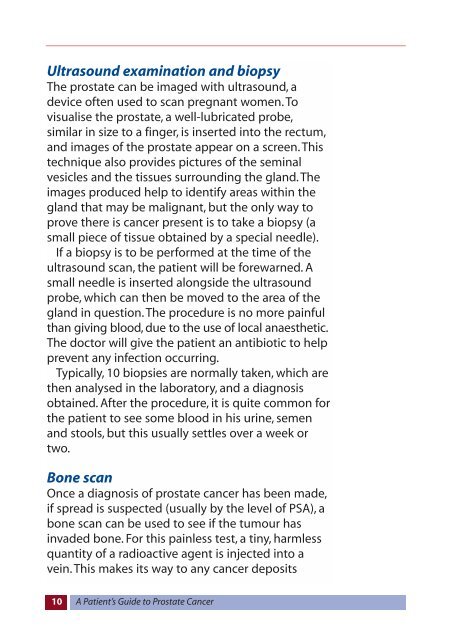A Patient's Guide to Prostate Cancer - Prostate Cancer Centre
A Patient's Guide to Prostate Cancer - Prostate Cancer Centre
A Patient's Guide to Prostate Cancer - Prostate Cancer Centre
You also want an ePaper? Increase the reach of your titles
YUMPU automatically turns print PDFs into web optimized ePapers that Google loves.
Ultrasound examination and biopsy<br />
The prostate can be imaged with ultrasound, a<br />
device often used <strong>to</strong> scan pregnant women. To<br />
visualise the prostate, a well-lubricated probe,<br />
similar in size <strong>to</strong> a finger, is inserted in<strong>to</strong> the rectum,<br />
and images of the prostate appear on a screen. This<br />
technique also provides pictures of the seminal<br />
vesicles and the tissues surrounding the gland. The<br />
images produced help <strong>to</strong> identify areas within the<br />
gland that may be malignant, but the only way <strong>to</strong><br />
prove there is cancer present is <strong>to</strong> take a biopsy (a<br />
small piece of tissue obtained by a special needle).<br />
If a biopsy is <strong>to</strong> be performed at the time of the<br />
ultrasound scan, the patient will be forewarned. A<br />
small needle is inserted alongside the ultrasound<br />
probe, which can then be moved <strong>to</strong> the area of the<br />
gland in question. The procedure is no more painful<br />
than giving blood, due <strong>to</strong> the use of local anaesthetic.<br />
The doc<strong>to</strong>r will give the patient an antibiotic <strong>to</strong> help<br />
prevent any infection occurring.<br />
Typically, 10 biopsies are normally taken, which are<br />
then analysed in the labora<strong>to</strong>ry, and a diagnosis<br />
obtained. After the procedure, it is quite common for<br />
the patient <strong>to</strong> see some blood in his urine, semen<br />
and s<strong>to</strong>ols, but this usually settles over a week or<br />
two.<br />
Bone scan<br />
Once a diagnosis of prostate cancer has been made,<br />
if spread is suspected (usually by the level of PSA), a<br />
bone scan can be used <strong>to</strong> see if the tumour has<br />
invaded bone. For this painless test, a tiny, harmless<br />
quantity of a radioactive agent is injected in<strong>to</strong> a<br />
vein. This makes its way <strong>to</strong> any cancer deposits<br />
10<br />
A Patient’s <strong>Guide</strong> <strong>to</strong> <strong>Prostate</strong> <strong>Cancer</strong>


